2016: marble pier table & high-back fancy chair

INTRODUCTION
I made just one decorative art acquisition in 2016–a c. 1830 marble-top pier table–but I’d like also to write about a rare high-back fancy chair purchased in early 2014 because its twin was auctioned off this year. The pier table in and of itself is interesting, but so is why I bought it, what research I did before purchase and what I learned after it came to live with us. Discussing the fancy chair allows me to admit how lucky I was to be able to remove its dark surface grime and how lucky I was not to bid on its twin.
Pier table
The pier table is an interesting form. As its name attests its function is to sit in the space–the pier–between two windows. Most often its top is marble. It usually has no drawers. The center of the back houses a mirror. The front often is composed of free-standing columns that rest on a shelf, which in turn rests on short legs. The form seems to appear in America around 1800 and continue, reflecting the current fashion, through the 19th century.
The piers in our 1850s Baltimore townhouse are rather narrow, too narrow for most pier tables. So acquiring one was not high on our list. Yet I admired the form. In 2013 my interest grew during negotiations with an antiques dealer to make her a floorcloth for her federal house in exchange for furniture from her inventory. Two of her three pier tables–particularly a stenciled 1810 Philadelphia one–interested me, but she wouldn’t budge on either of them. I have no regrets, however, with the over-mantel mirror and card table I ended up with. (See the making of her floorcloth at: http://www.scottponemone.com/floorcloth-painted-canvas-for-1806-hallway/)
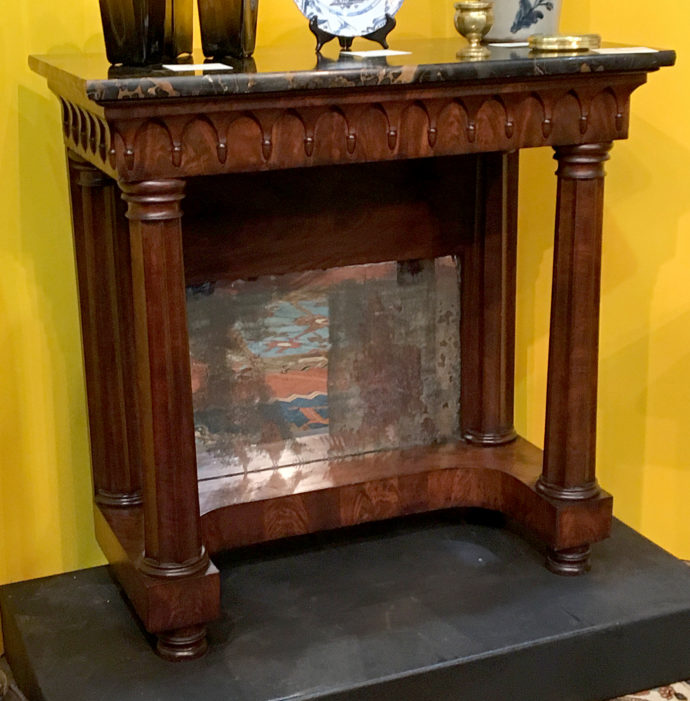
We first saw our pier table on display at the Original Semi-Annual York Antiques Show and Sale in Sept. 2016.
Our search ended at an antiques show in York, PA, this September. I immediately liked the strength of its broadly fluted tapered columns and pilasters as well as their simple Doric capitals. The frieze under the marble top of pointed Gothic arches and acorn-shaped corbels was equally attractive. The top of what is usually referred to as Egyptian marble was stunning.
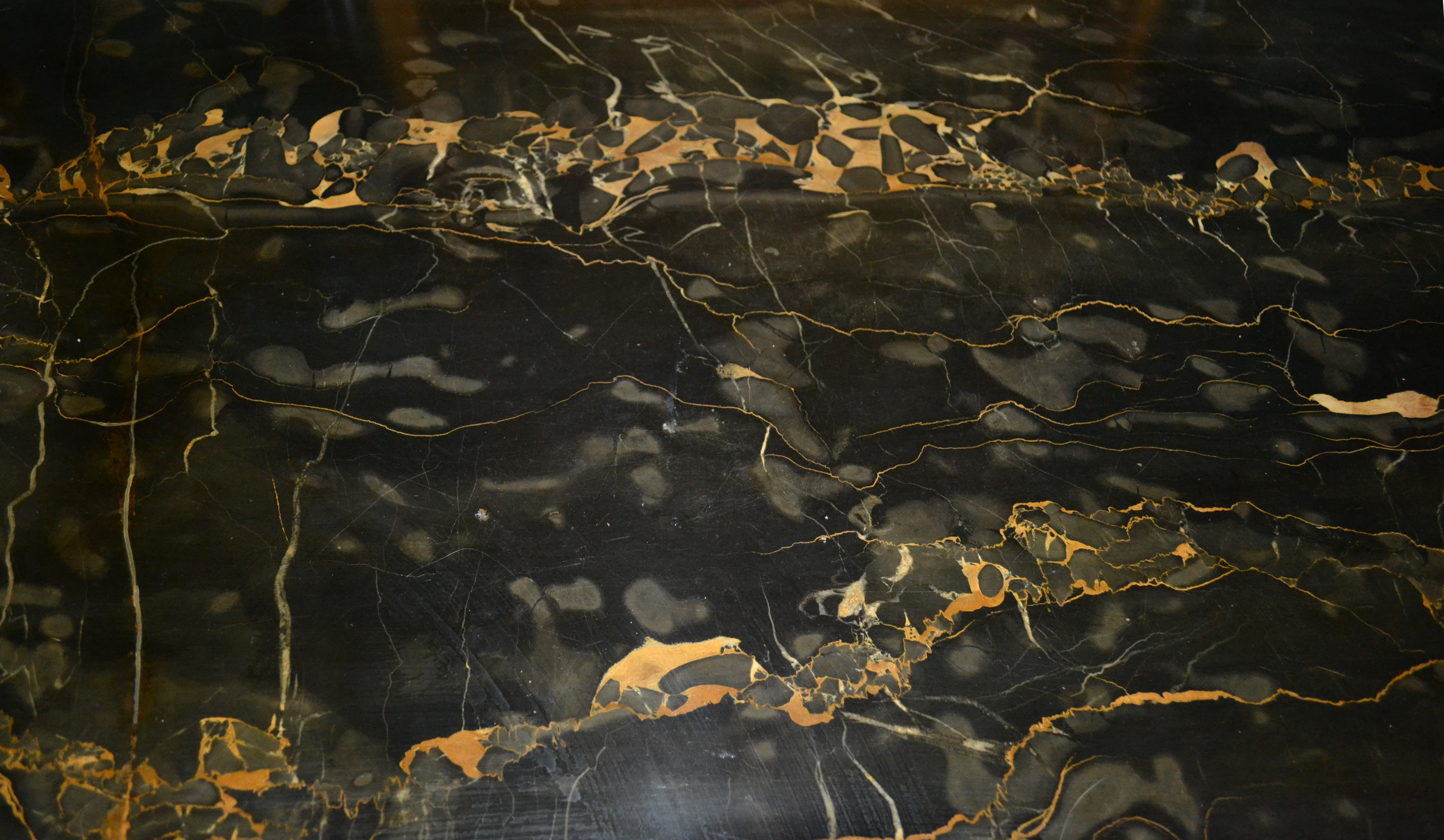
Even the mirror plate with its severe flaking was a positive because it was original (and not to be seen at face height). The other condition question was the repair to the marble. It had broken. The break followed the pale, rather straight vein visible near the left edge of the image above. There had also been a few small repairs to the mahogany veneer.
The asking price seemed fair. But other than taking a few photos and asking the dealer (from Kentucky, this being his first York show) for his card, I left the show without making a bid on the table. But negotiations had in fact begun.
The first task was to go home and look online for auction records for similar tables, maybe even finding the sale of the exact table. I would also check books for similar tables.
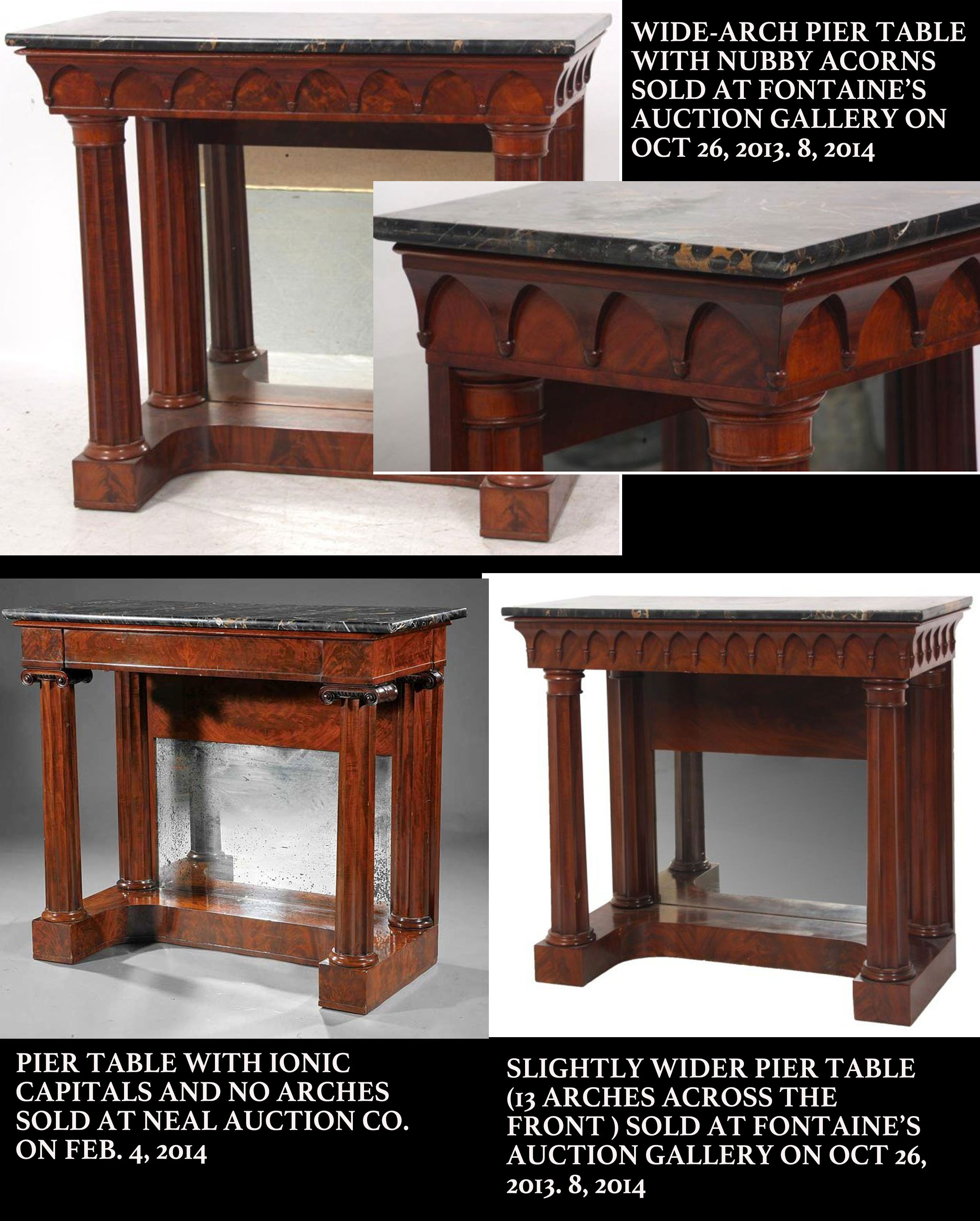
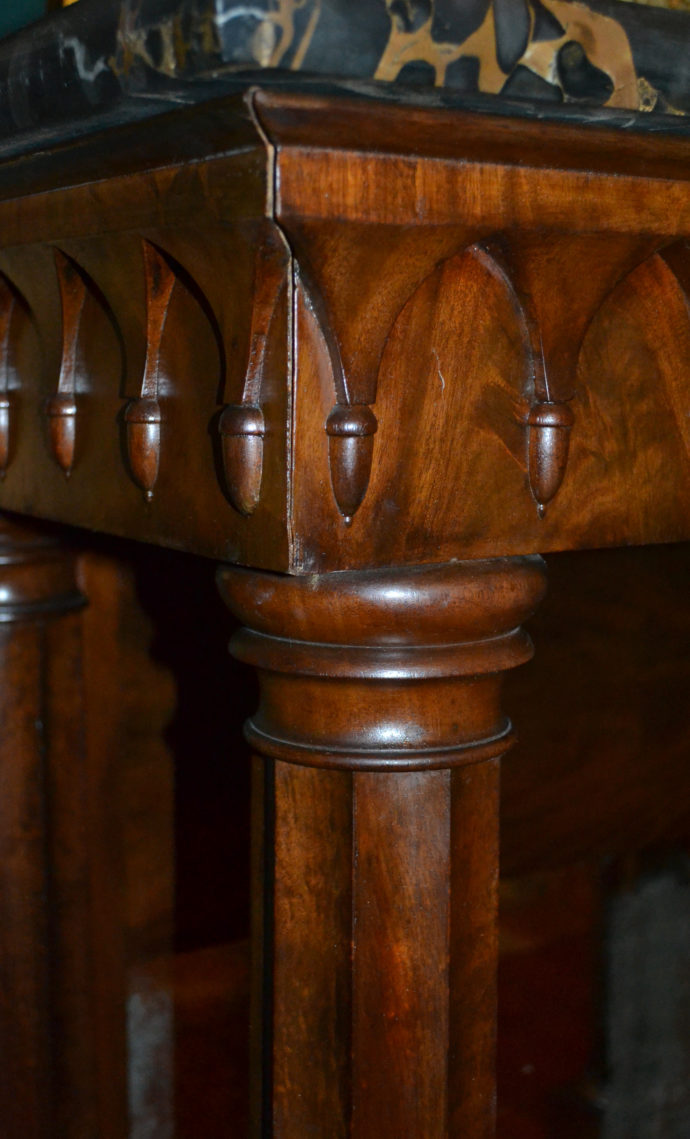
Corner of the frieze on my table.
Well, my reference library failed me, but the liveauctioneers.com site didn’t. While I didn’t find “my” table, I did come across some variations, and the auction prices suggested that the one I saw in York was fairly priced. The top example had much wider arches, nubby acorns and the frieze corners differently than “mine.” The frieze (shown above on the right) corners with a completed arch both on the front and on the side so that an acorn wraps around the corner. On what would become my table (right) and on the example above, lower right, the frieze corners at the top of the arch both on the front and on the side.
So the example on the lower right is closer to mine. It’s wider–by one arch across the front; its capitals are somewhat different. The height of its mirror plate–probably replaced–is the same. (Note that in the example on the top, the mirror plate is taller.) The top example also has a flat bead running below the acorns and at the base of the plinth. There’s no bead anywhere on mine and on the lower right example.
I include the example on the lower left just to show a variation. The column shafts are the same, but the capitals are Ionic. The arch frieze is missing, but the flat bead is present. The mirror height matches the one on mine.
All three examples have black Egyptian marble. Like my table, the marble tops on the top and lower right examples have been repaired. Maybe the dramatic veinage of this marble makes it subject to breakage.
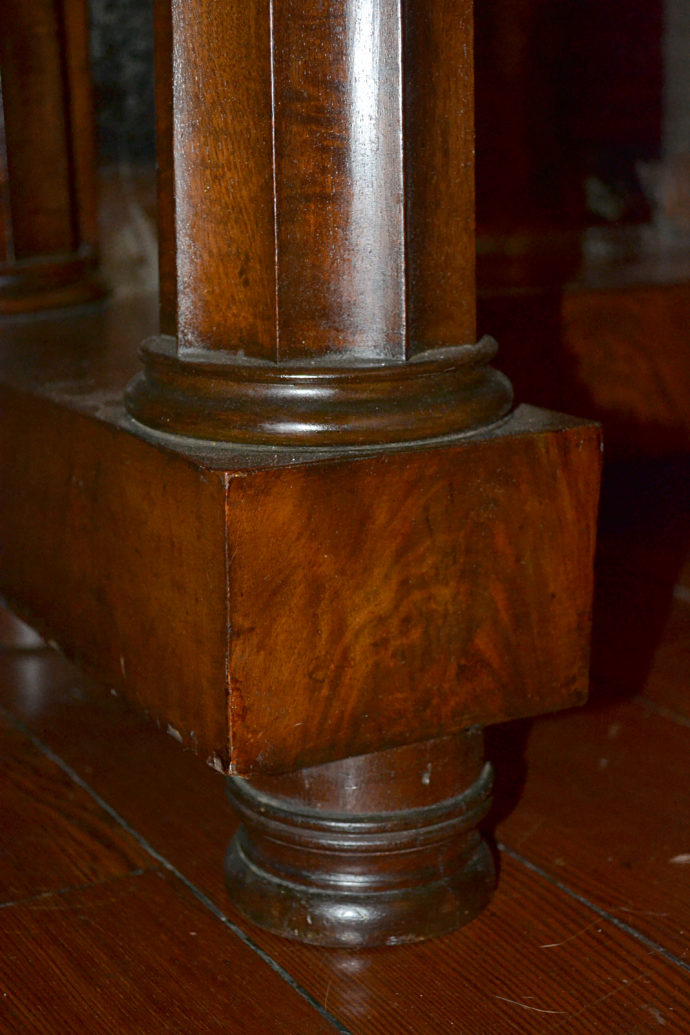
So we saw the table on Friday. I did my research on Saturday and tried to hold off calling the dealer until Sunday. But I couldn’t constrain myself. Late Saturday I offered him 20 percent less by email. He countered saying he couldn’t go below a 10 percent discount. That’s as far as it went until Sunday morning, when I called him. We chatted a bit. He claimed he’s had a lot of interest in the table and so refused to drop the price further. In short I yielded, but would he accept about three/eights now and two equal checks for the balance post-dated for late October and late November. He agreed but wanted the initial payment in cash when he delivered the table. (Free delivery!)
One other point: Only my table had feet (left). The ones I saw online were in the French console style–without feet. So when the dealer arrived, I checked the bottom of the feet before he removed the table from his vehicle. Were the feet added? I figured that if they were, they would have to have been screwed in from the bottom. But there were no screws. Rather each foot had three wire nails toenailed in (hammered in at an angle) near where the each foot met the plinth. This was done, I suspected, because the tenons had become loose. (In the photo you can see the head of one of the nails. It’s the very small bright spot above the highest ring turning of the foot.)
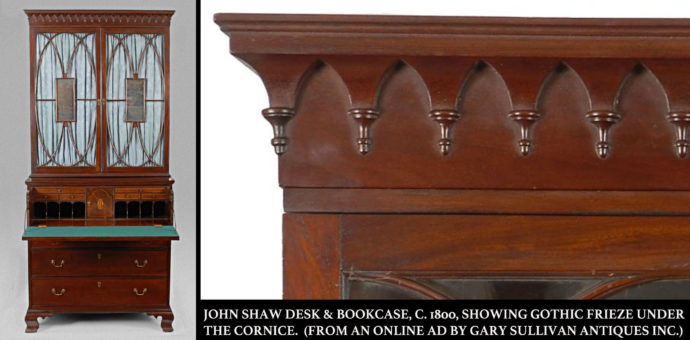
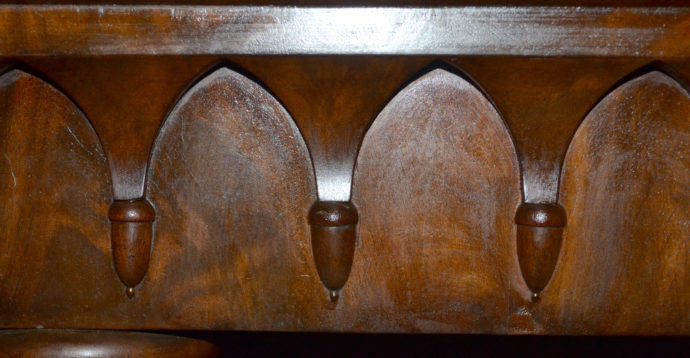
The arch-and-acorn frieze on my pier table.
With its very Greek columns my pier table fits nicely in with late neoclassical American furniture, maybe 1830s. The frieze of pointed arches is called Gothic. While pointed arches are associated with the short-lived American Gothic Revival style of around 1840 and the 1850s, American cabinetmakers were incorporating pointed arches much earlier. Above is a desk and bookcase by John Shaw and his workshop in Annapolis (active 1770 to around 1825). Shaw used pointed arches as early as 1790. The above example is from around 1800. (See more examples at: http://www.chipstone.org/images.php/564/American-Furniture-2006/) Baltimore cabinetmakers used pointed arches on cabinet doors–particularly on sideboards–as early as 1815.
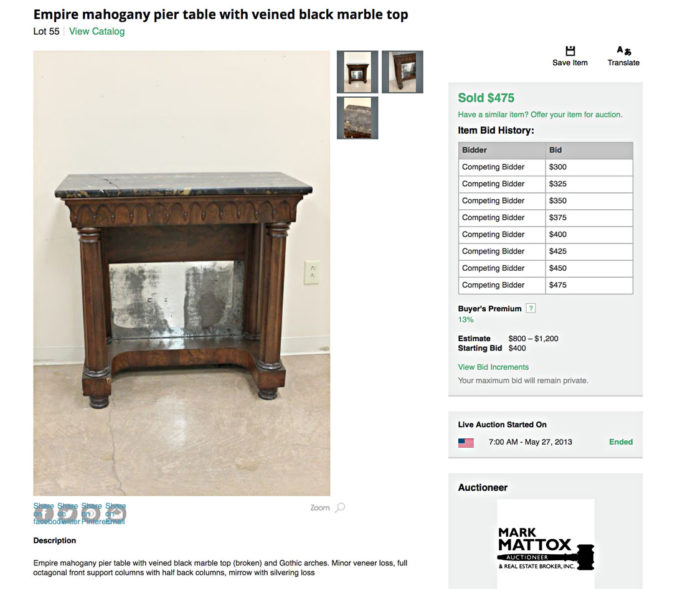
Guess what? Another search, another result. I think this time I might have written “Empire pier table” when searching sold items at Live Auctioneers. It certainly is my table: pre-repair to the marble, identical mirror flaking and little turned feet. Being an inveterate bargainer, I admit I was a little taken aback with the $475 hammer price. That’s only $536.75 with 13% buyer’s premium. I wondered if the seller of my table was the winning bidder for it at the May 27, 2013, Mark Mattox auction. So I had to ask.
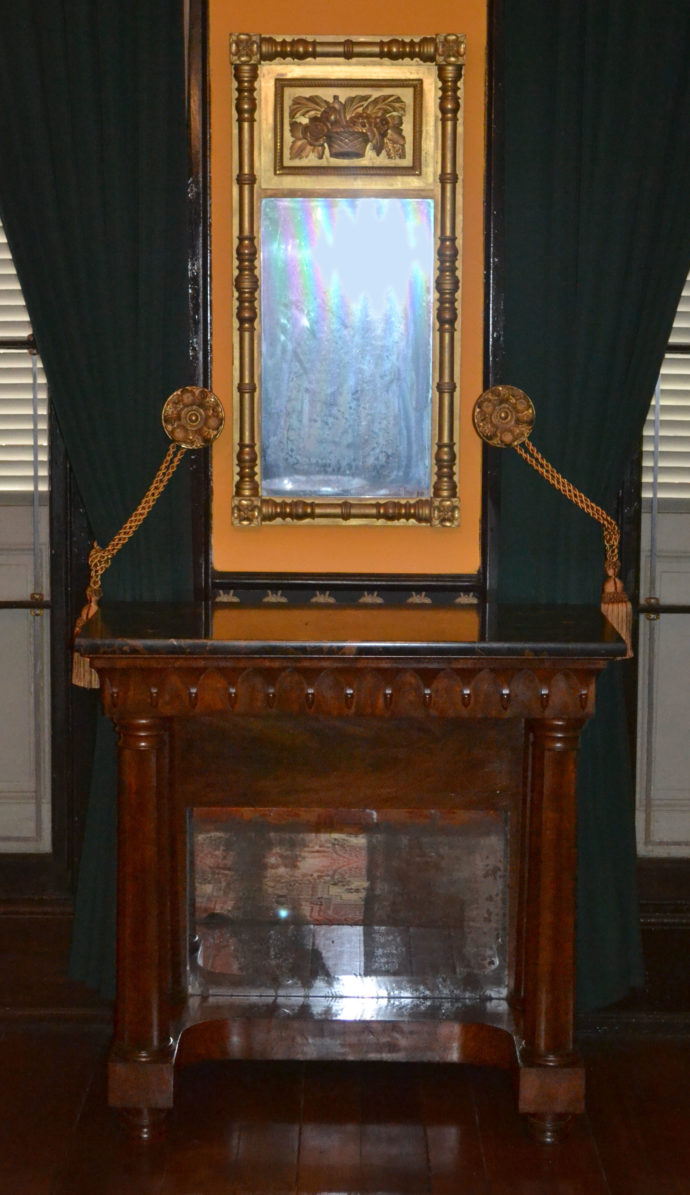
The pier table in its pier in our dining room, where the curtains hide how narrow the pier is.
Taylor Thistlethwaite of Thistlethwaite Americana (that’s www.thistleamerica.com) graciously agreed to answer some questions:
“I actually did not get that table from Mark Mattox. I purchased the piece in the late of 2015 from a well published art historian from Paris, Kentucky, who was moving to Brussels. Yes, he did get a good deal on it, but I didn’t pay that amount. After purchasing the piece, I had the marble and some minor veneers repaired, which cost considerably more than the Mattox purchase price. The finish wasn’t touched with the exception of cleaning and waxing the piece.
“The size and quality of the piece made it rare. Also, in Kentucky classical pieces are not especially popular. Most antique collectors in this area prefer regional material or high-style English. Empire furniture of good scale I felt could do well in an urban environment or in the Deep South. I actually wasn’t going to put the pier table out at York, but rather save it for the Main Line show the following week. However, earlier that week I sold a PA chest that I was going to put in that spot. When I arrived at York, there was very little formal furniture and hardly anything Empire. Being my first time at the show, I felt that table might make me stand out from the rest of the dealers. Wouldn’t you know, it was the most popular thing in my booth. Actually, after I accepted your deal, I had two other people call me about the table.
“Formal furniture is a tough sale today unless it is the best of the best. Empire is especially tough. I felt that your table was special. Although it had a repair to the marble and some veneer repairs, it had a presence. The size and the black marble with the rich mahogany made a special package. In today’s antique market small and quality sells. I only represent pieces that I would want to live with and that piece tugged at my heart.”
RED CHAIR
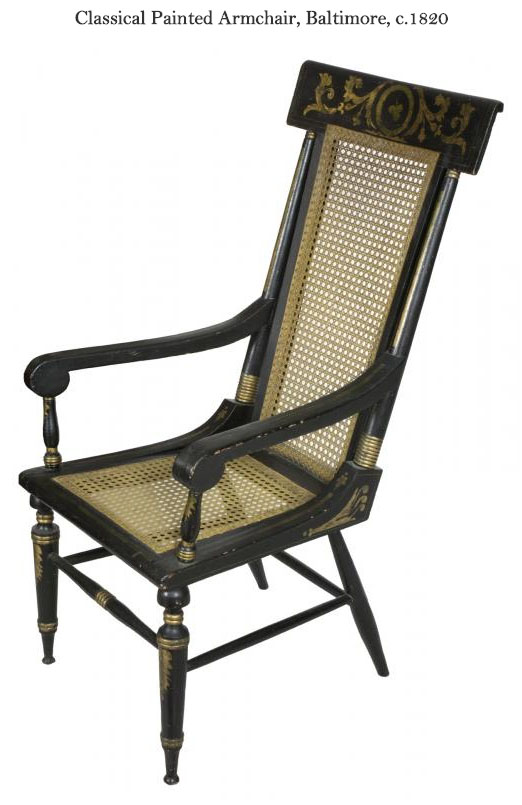
I’ve written a few times about painted furniture, a genre that was popular in federal America. Here are two posts: One features six mid-19th-century chairs by Lancaster, PA chairmaker John Swint (http://www.scottponemone.com/2015-recap-decorative-arts/), and one discusses learning to read painted furniture surfaces (http://www.scottponemone.com/painted-furniture-learning-about-original-surfaces/) Missing from those articles is something that’s quite uncommon: a high-back fancy chair. “Fancy” here indicates a piece of federal furniture had some combination of bright colors, faux graining (either simulating real wood grain or playfully referring to it), stenciling, gilding, and/or free-hand painting.
Baltimore was a mecca for fancy painted furniture, particularly chairs. But high-back ones are rare. For years I’ve followed online one on the Stanley Weiss Collection website and watched its price fluctuate from $6,000 to currently $15,000. (http://stanleyweiss.com/item/sw00431) It’s a nice chair, definitely in the Baltimore mode, although the painting is quite crude.
So I was primed when I came across the red-painted one at the 2014 winter version of the Original Semi-Annual York Antiques Show.
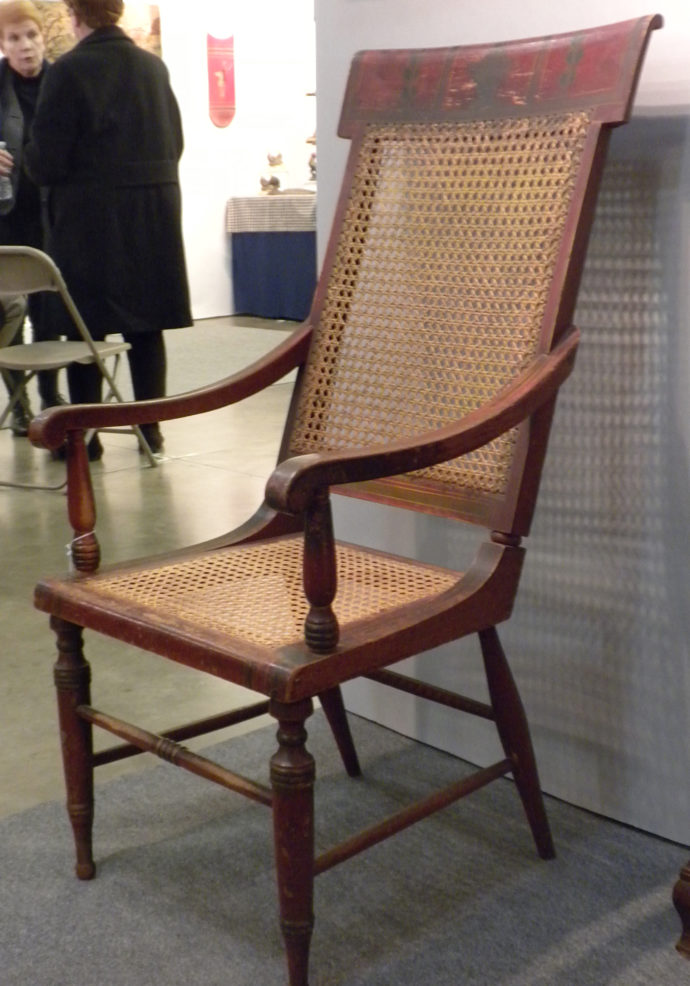
It sat in the booth of Kelly Kinzle. It certainly resembled the Stanley Weiss one: very close to the same feet front and back, same tablet crest rail with rolled top, similar arms and very similar arm stumps. The biggest difference was the back. The frame for the caning on the red chair’s back was identical to the back itself. In the Weiss model there are two pairs of back stiles: a turned pair that the arms are attached to and a unturned pair that the caning is attached to.
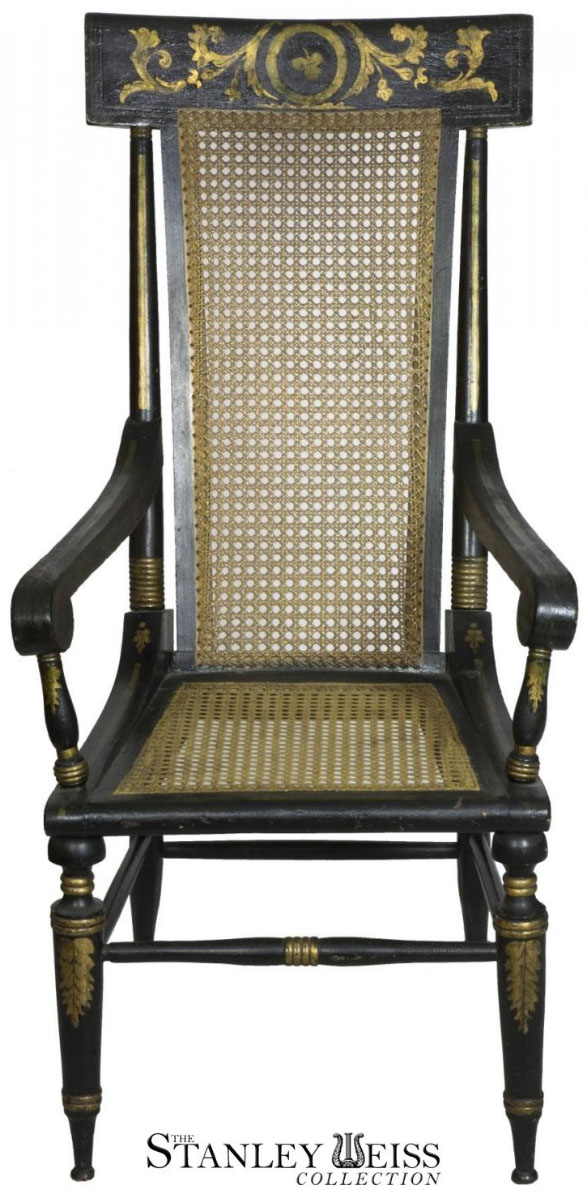
When I placed photos of the red chair on Facebook, one furniture expert thought it wasn’t a Baltimore product, but Gregory Weidman, author of Furniture in Maryland, 1740-1940 and currently curator of the Hampton National Historic Site, suggested the components were of Baltimore manufacture but that the painting was not, i.e. the pieces of wood were shipped to somewhere (probably southern Pennsylvania) and assembled and painted there. There was that unusual since painted chair making was often an assembly-line process. For instance a turner down the street could make the legs for you, while the guys in your shop did the rest.
Anyway, the chair sure was grungy. I had this stuff. I decline to name it other than saying it was a gel. I had bought it years ago to clean up other painted pieces. But I had barely used it, fearing it could inflict non-reversible damage to original surfaces. Yet I tested it with cotton swabs on an out-of-the-way part of a rear leg. Swab it on, wait a few minutes, and the gunk started to wipe off, and the red base color started to glow. So with my confidence growing, the area swabbed and cleaned grew and grew. The last area was the most prominent: the tablet crest rail.
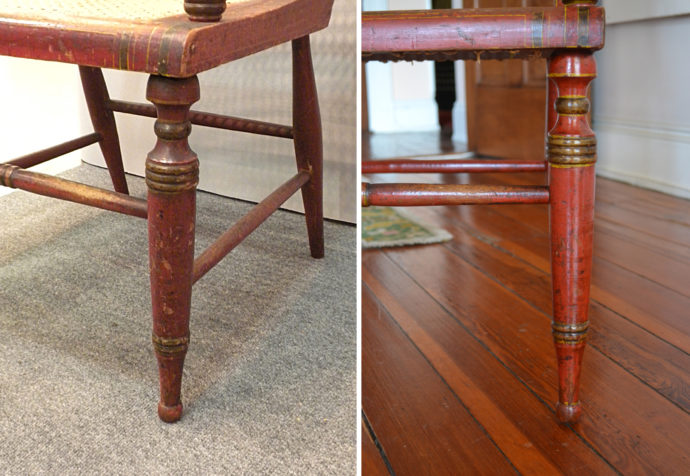
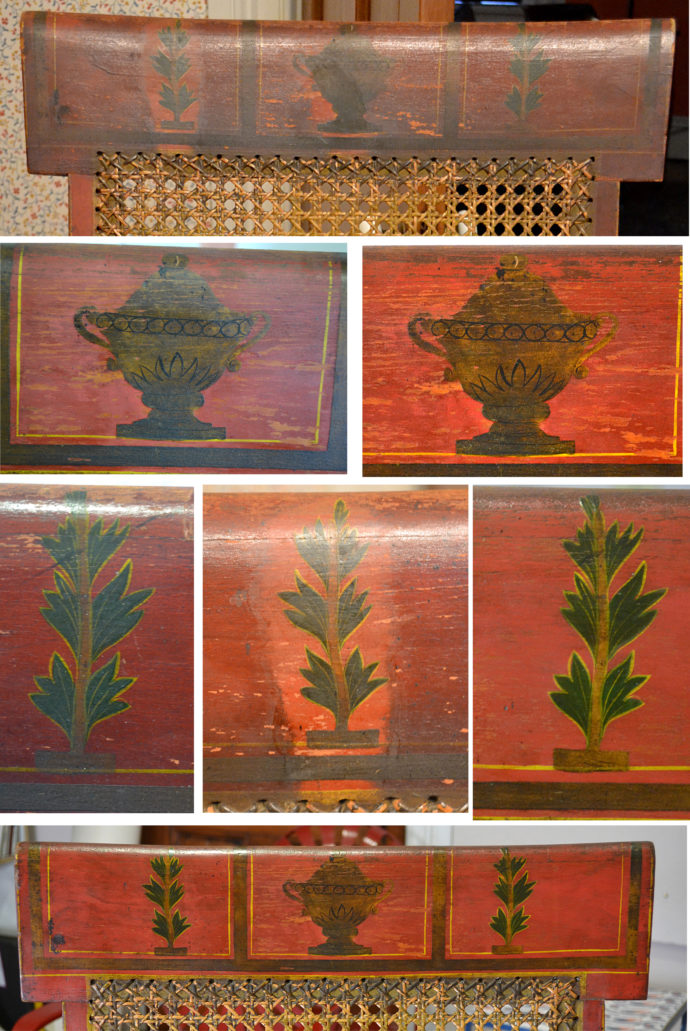
The covered urn on the crest rail certainly seems appropriate for a neoclassical image choice c. 1830. True, the painting is crude, but it looks untouched. Ditto for the pair of laurel or acanthus sprigs on either side. And the base color–often called Pompeian Red–was a striking choice, totally showy and the height of fashion.
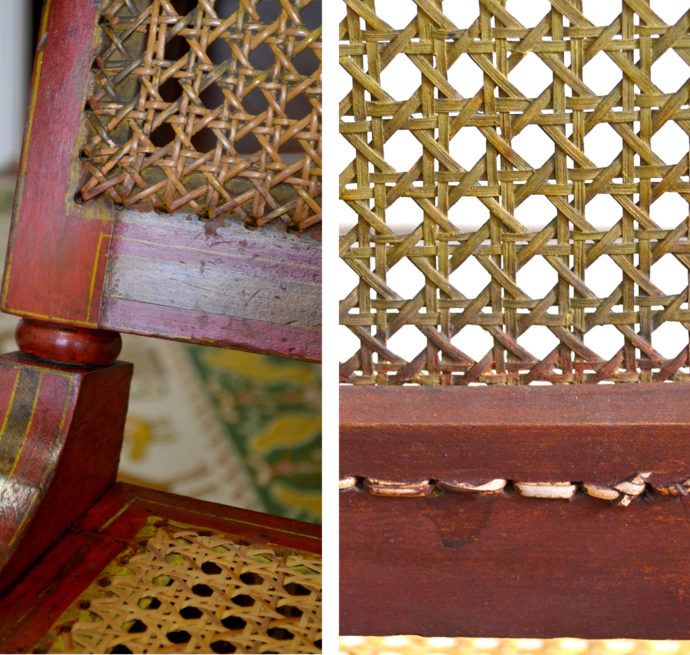
(left) A partial view of the back and seat caning from the front and (right) a partial rear view of the lower back rail and caning. (P.S. I didn’t clean or shellac the back of the chair.)
As I cleaned it, I came to realize that the caning on the back was probably original. Since I strongly believed that chair had never been repainted or over-painted, I read the evidence of the red paint (see right image above) on the back of the caning and where the cane wraps between the holes on the rail to indicate that the caning had never been replaced. If you look closely (left image) on the caning of the back, you can pick out traces of yellow paint. The show side of caned seats or backs were usually painted, yellow being the common choice. The seat caning is clearly bright and new and unpainted.
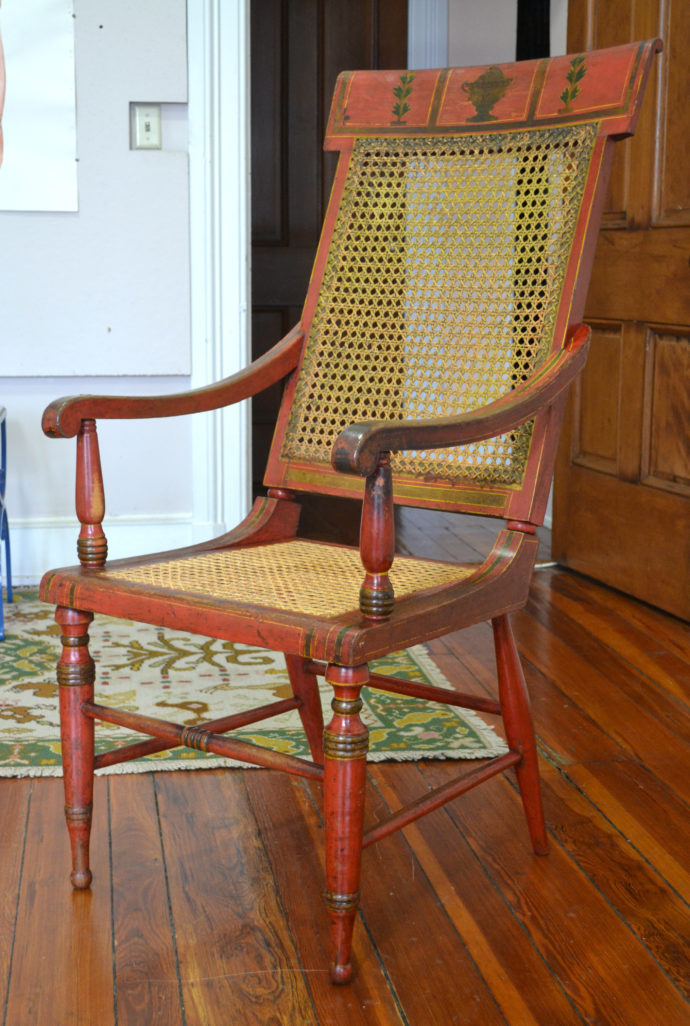
After cleaning, I did a light coat of white shellac and applied and buffed a layer of paste wax.
Kelly Kinzle thought the chair may have been used by a fraternal order, a grand master’s chair perhaps. But the urn and sprigs didn’t point to any order I was familiar with. It certainly would enhance a private office as well as some judicial or civic setting. How unique it was partially answered by this auction notice:
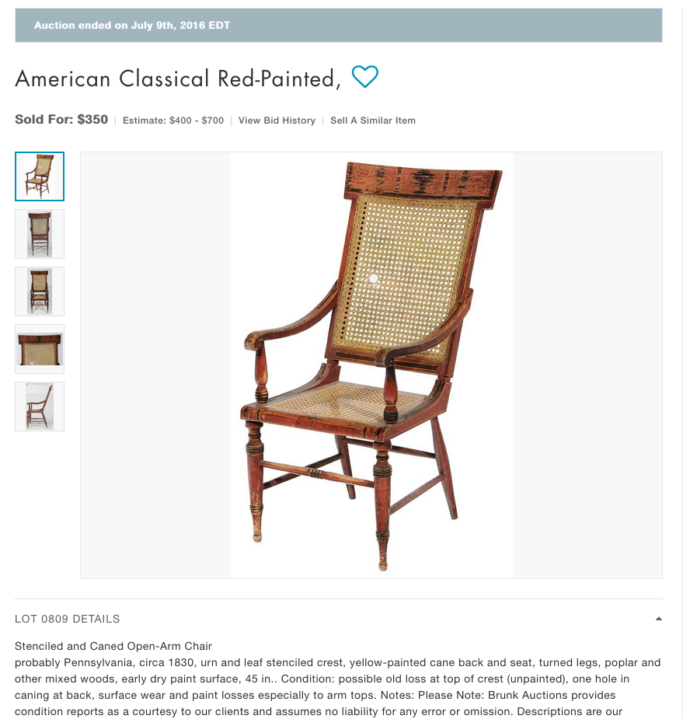
It sold last July at Brunk Auctions for $350, or $441 with buyer’s premium. It was exciting to see my chair’s twin, but I never considered buying it since the crest rail was in rather poor condition.
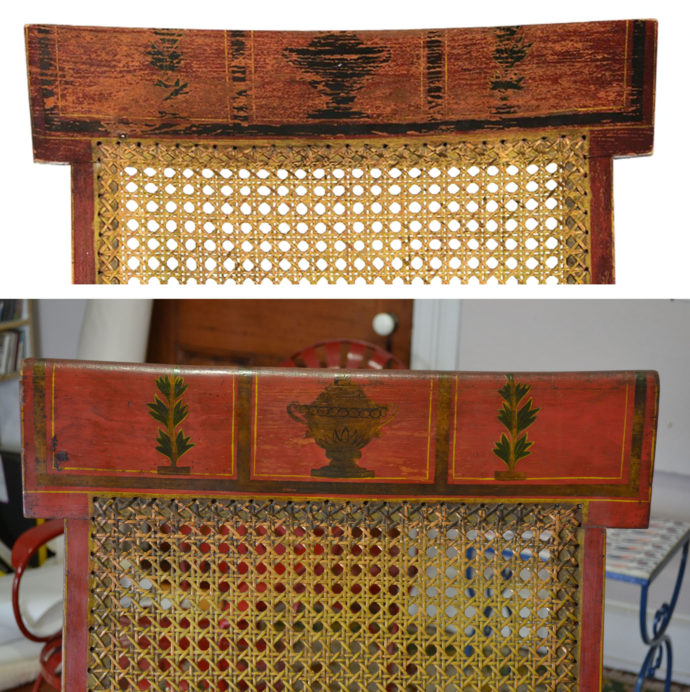
Crest rails of the Brunk chair (top) and my chair (below).
When prepping the Brunk image for this post, a phrase caught my eye for the first time: “possible old loss to top of crest (unpainted).” So I created these images to see if I could confirm the “loss”:
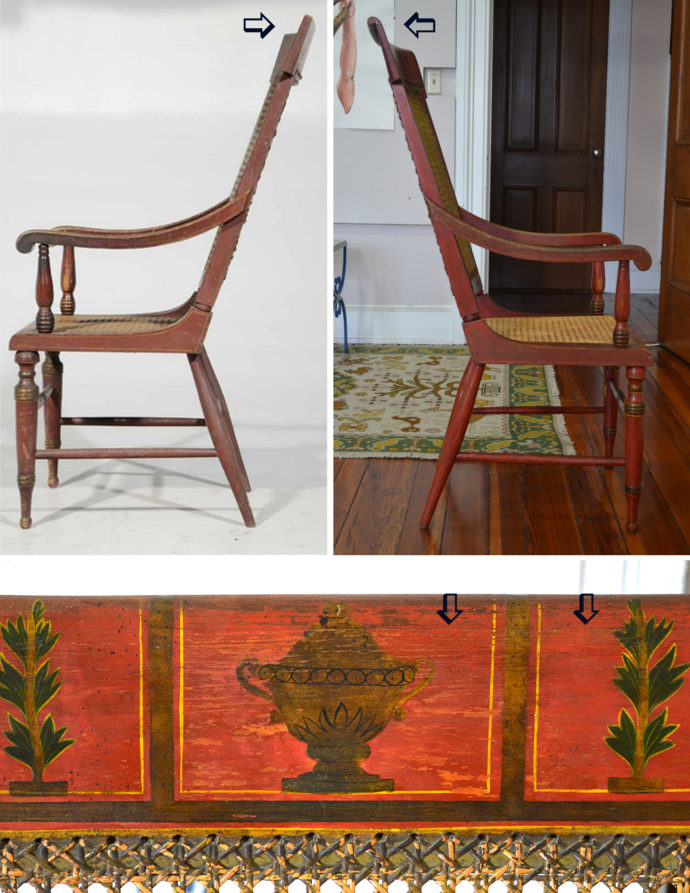
The Brunk chair in profile is on the left, mine on the right. The arrows show that the cress of the Brunk chair has a squared off top edge, while mine had what is called a rolled top. This is created by gluing a piece of wood with its curled back atop the larger flatter crest rail. (This lamination saves on wood and work.) On the lower image the pair of arrows point to a faint horizontal line where the two pieces were glued together on my chair. And if you look back on the pair of crest rail photos above, you can see that darkened urn and sprigs on the Brunk chair crest rail are lopped off because the rolled top is missing.
In short I’m even happier I didn’t bid on the Brink chair. Now I wonder if there’s a third chair out there.
Trackback URL: https://www.scottponemone.com/2016-marble-pier-table-high-back-fancy-chair/trackback/











Hi Scott –
I have acquired what I believe is a Baltimore “Fancy” chair–a rocking chair with caned seat and back. I wonder if you might be willing to take a look and give me your impression.
I live in the correct region to have acquired it (about 45 west of Baltimore). It is lovely, but was a bit of a mystery to me as I was unable to find another on the internet. My mother sorted through all of her reading materials, etc. and believes it to be a “Fancy” chair. I’m really excited about it. Thank you and please let me know if you would be willing to take a look.
Best wishes,
Leslie Harned